s across wave boundary layer processes for the coupled atmosphere-ocean models. In the last two decades, tremendous progress has been made to use imaging techniques like an in-situ ethernet-based (CBLAST-LIVE) and a real time self-contained video system (CBLAST-EYE) for observing air-sea surface wave characteristics at the Air-Sea Interaction Tower (ASIT) off the south shore of Martha’s Vineyard. In addition, observations of subsurface wave and current have been measured. The project is one component of the Coupled Boundary Layers, Air-Sea Interaction Experiment in Low to Moderate Winds (CBLAST-LOW).
 s
s 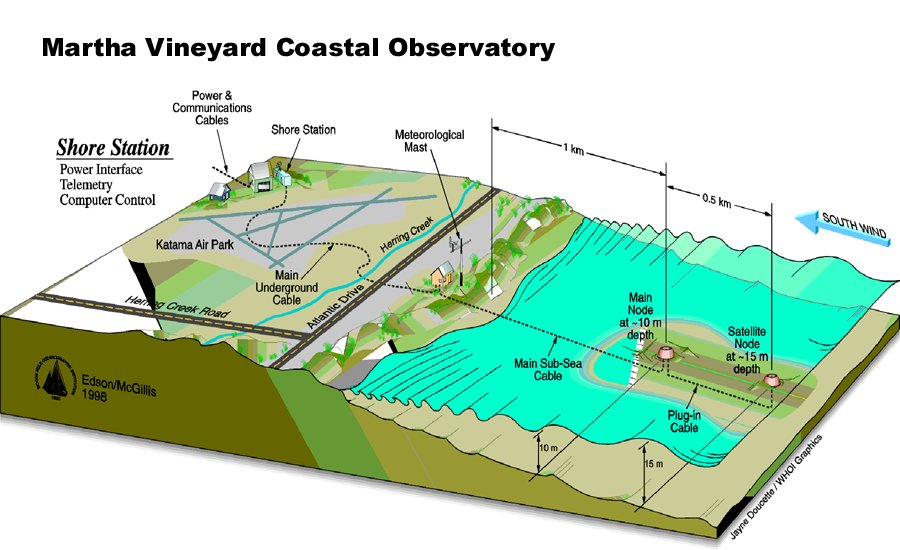
3D and Wave-current induced breaking waves Processes of air-sea interactions Observatory for air-sea interactions
An image taken from the ASIT
during the experiments is shown here. Using a digital
photogrammetry processing technique, the whitecapping area
can be estimated from the rectified ortho-image and
correlated with the recorded wind speed. In addition, the
following ortho-image shows a developing Langmuir streak
under a wind speed of approximately 5 m/s. Time series of
whitecapping areas other concurrent measurements are
correlated to obtain breaking-wave induced parametrization
of momentum, heat, and humidity fluxes momentum, heat, and
humidity fluxes.
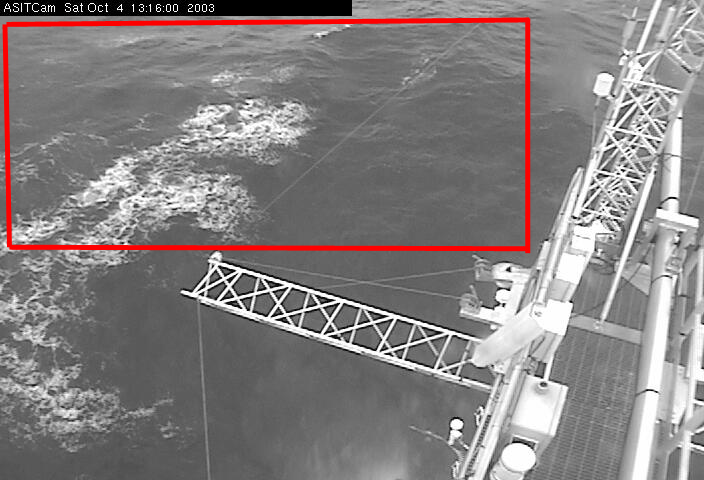
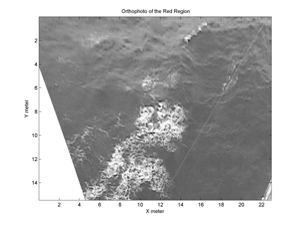
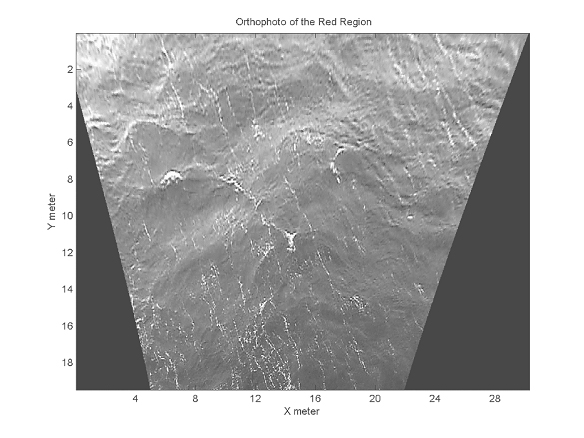
Breaking waves at the ASIT
Orthophoto of the
marked red area
Langmuir Circulation
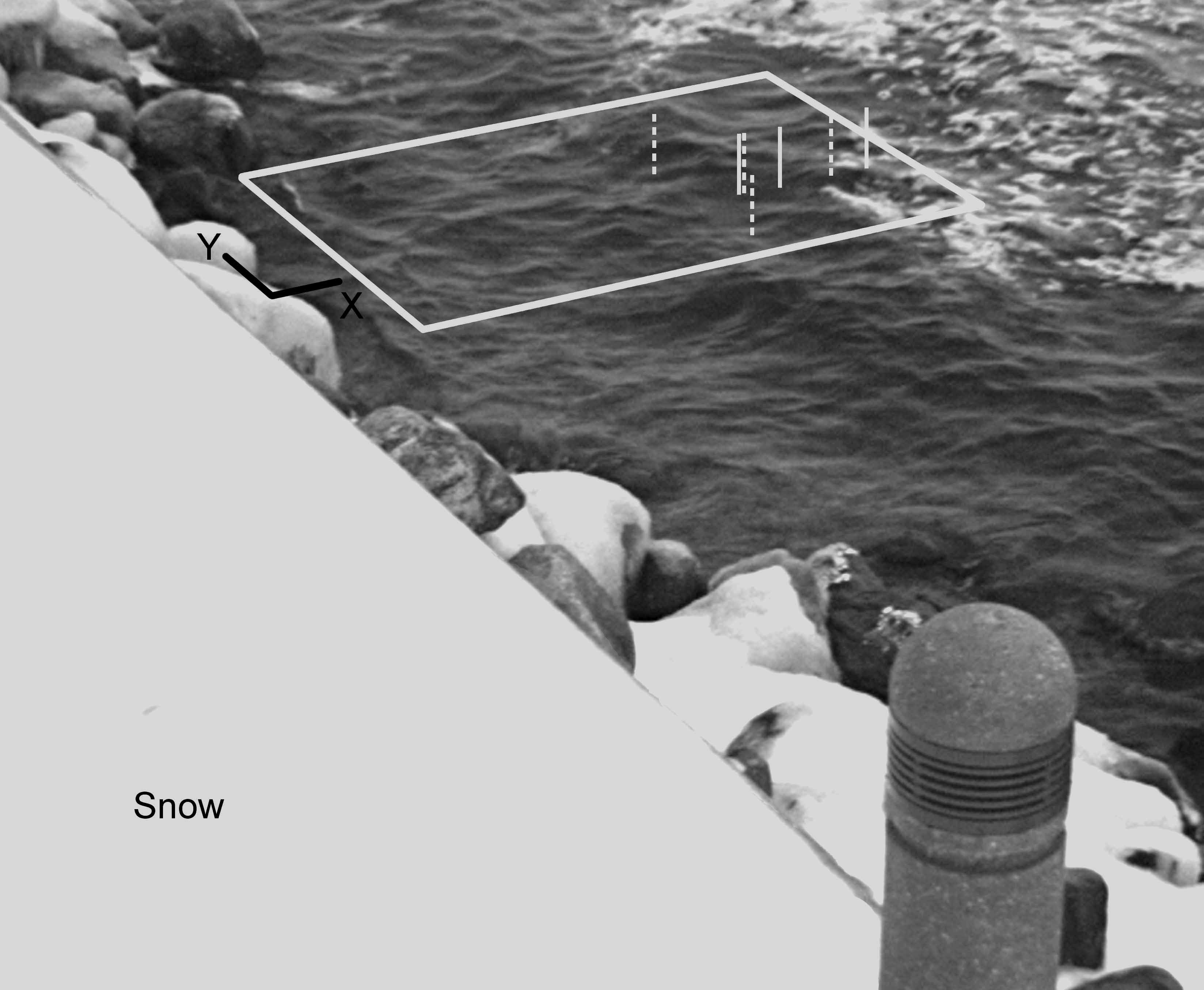
Stereo-imaging of a 3D breaking wave 3D view of the processed image Virtual wave gauge array
Efficient and accurate modeling of surface wave motions plays an important role in many coastal and ocean. For several decades, a great deal of efforts has been paid to develop unified models that can effectively predict water wave propagation with varying degree of dispersive and nonlinear effects. Our research group is focusing on develop an efficient and accurate non-hydrostatic modeling frame to predict large scale surface wave dynamics. Overall the goal is to develop full non-hydrostatic model using a small number of vertical layers (two ~ five layers) to simulate nearshore wave transformation including shoaling, dispersion, refraction, and diffraction phenomena. Furthermore we are also working on developing a non-hydrostatic model that can examine deep-water wave-wave interactions including slowly modulated and rapidly evolving wave processes leading to the formation of freak waves.
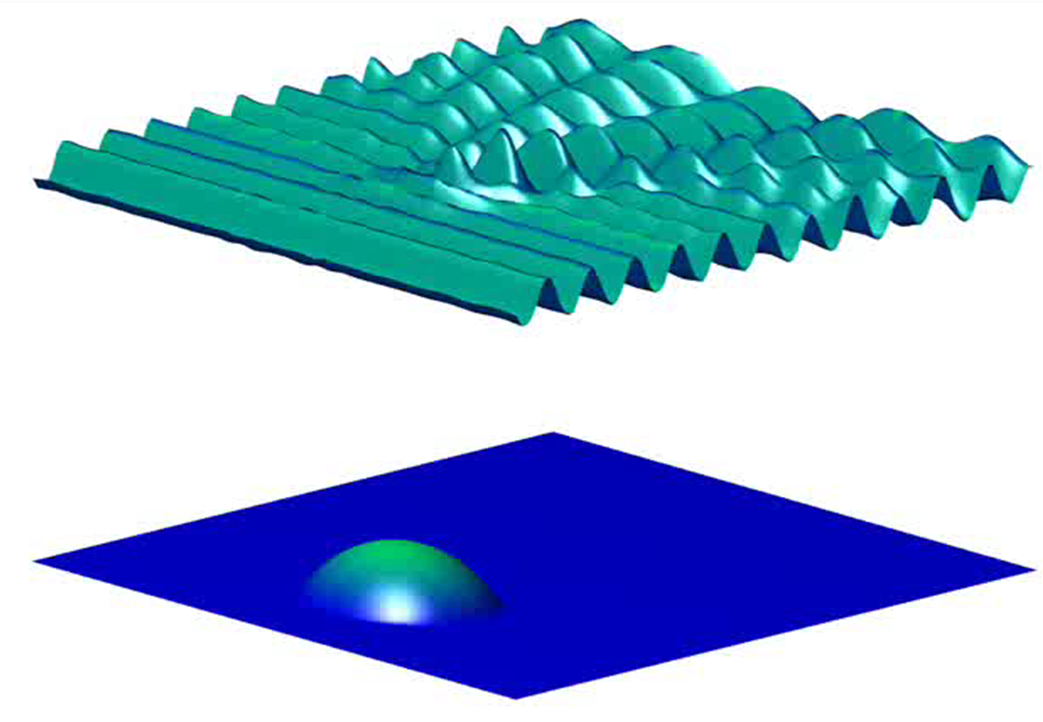
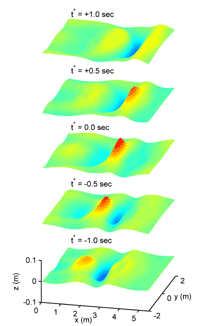 Shoaling and
diffraction
Refraction and
diffraction
Frequency dispersion focusing
Shoaling and
diffraction
Refraction and
diffraction
Frequency dispersion focusing The Apostle Islands lakeshore in Lake Superior is a world-class destination for sea kayaking, luring paddlers with scenic wilderness, ancient geology and a rich cultural history. Some of the most popular attractions are the sea caves located at several spots around the archipelago. The water environment in the Apostle Islands is undoubtedly quite complex and dynamic due to the interactions of winds, currents, and the surrounding 22 islands at the site. Waves generated in Lake Superior can diffract and reflect when they encounter the islands and may combine to form extreme waves or freak waves in a process known as geometric focusing. This process is applied to determine local regions of energetic wave fields for use in wave power generation around the world. In addition, significant energy and momentum transfers can occur during the wave and current interaction, yielding extreme waves that can affect the navigation and kayakers' safety. To date information of wave climate in Lake Superior is very little. Currently we are developing an in-situ Real-Time Wave Observation System (RTWOS) that can be accessed through any portable wireless device. Furthermore a real-time INFOS-Apostle is currently developed to provide real-time wave climate in the Apostle Islands. Outreach efforts (see Wisconsin State Journal Article has been continuously paid to address the community and society needs. An energy efficient push button Real-Time Wave Kiosk System (RTWKS) is also designed, built, and installed at the Meyers Beach, WI, where most kayakers/boaters enter water in Lake Superior. The benefit of providing certain conditions in favor of the occurrence of dangerous extreme waves/freak waves is critical for the warning kayakers and boaters in Great Lakes. Recent articles related to the freak waves and RTWOS can be found at UWMadScience and Sea Grant News.
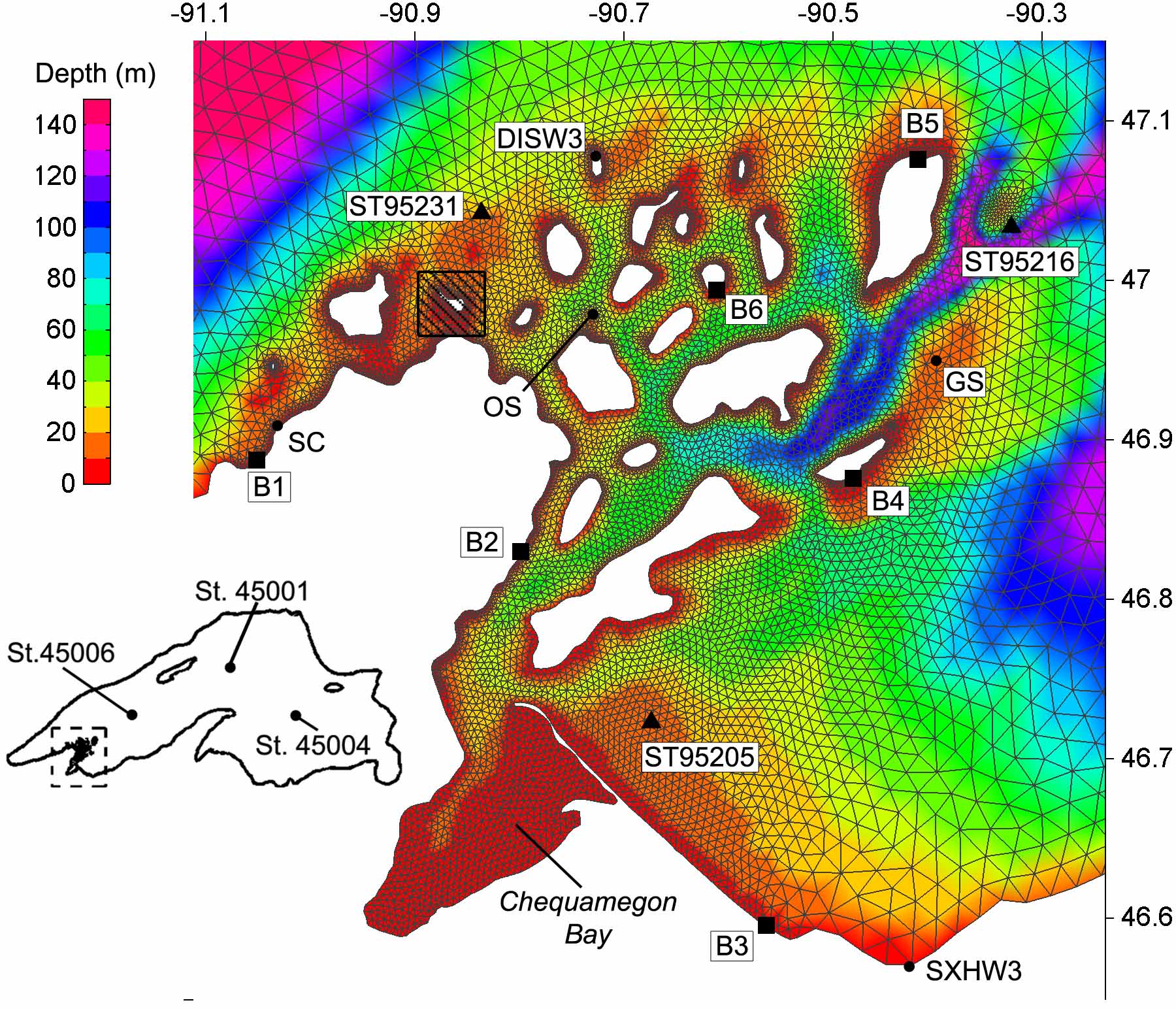
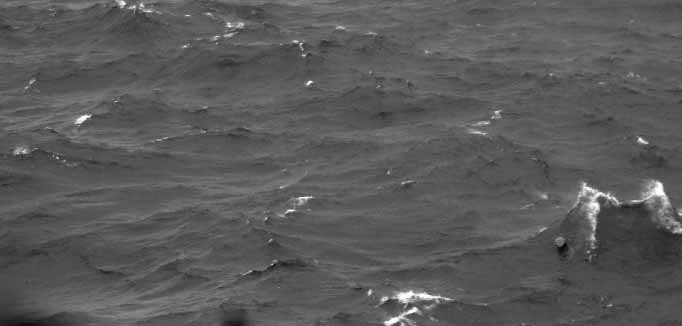
Apostle Islands in Lake Superior Real-time wave buoy and nowcast/forecast modeling 15 feet freak wave
Meteotsunamis can pose a serious threat to the Great Lakes coast, owing to the lake’s characteristics that facilitate the formation of destructive meteotsunamis including frequent fast-moving storm fronts, resonance-promoting bathymetry, and harbors to finally amplify the wave. The most vivid historical meteotsunami on record in the Lake Michigan occurred in 1954, when a squall line-induced longwave wave struck Chicago in Lake Michigan. The coast was inundated up to 50 meters inland and unexpectedly swept many fishermen off of the Montrose Harbor piers, killing seven. While the threat of meteotsunamis in Lake Michigan has been recognized, to date no infrastructure for detecting and warning of a pending meteotsunami disaster is available. Recently the potential hot spots in Lake Michigan that can be threatened by meteotsunamis has been identified and characterized. Meteotsunamis have also observed in Lake Superior and Lake Erie. In collaboration researchers in Great Lakes Environmental Research Laboratory and Prairie Research Institute at the University of Illinois at Urbana-Champaign, we are implementing an observation network system to better understand the occurrence of meterotsunamis. An operational meteotsunami forecasting and warning system is also being developed to keep residents safe and avoid dangerous events.
Coastal Storm Program, NOAA
Cooperative Institute for Limnology and Ecosystems Research
NSF-Ocean Science
Office of Naval Research
UW-Madison/UW-Milwaukee Intercampus Research Incentive Grants Program
University of Wisconsin Sea Grant Institute, NOAA
Wisconsin Alumni Research Foundation
Wisconsin Coastal Management Program - Freak waves in Apostle Islands
Wisconsin Hilldale Faculty/Undergraduate Research Fellowships
Status : Active
Student Investigators:
Adam Bechle (post-doc), Josh Anderson (post-doc), Alvaro Linares (PhD), Yuli Liu (PhD), Michael Meyer (MS), Chen Jin (MS)
Graduated: Josh Anderson (PhD), Adam Bechle (PhD), Alex Campbell (MS), Jay Young (PhD), Doo-Yong Choi (PhD), Henry Yuan (PhD), Aifeng Yao (Ph.D.), Adam m Bechle (MS), Justin Wanek (MS), Chris Petykowski (MS)
Collaborators:
Dr. Eric Anderson, NOAA, Great Lakes Environmental Research Laboratory
Dr. David Kristovich, Prairie Research Institute, Illinois State Water Survey
Dr. Alexander B. Rabinovich, P.P. Shirshov Institute of Oceanology, Russian Academy of Sciences
Dr. David Schwab, Graham Sustainability Institute, University of Michigan
Dr. Paul Liu, NOAA, Great Lakes Environmental Research Laboratory
Dr. Joseph Zhang, Virginia Institute of Marine Science
Openings
Publications
-
Linares, A., Wu, C.H., Bechle, A.J., Anderson, J.A., and
Kristovich, D.A, Unexpected rip currents induced by a
meteotsunami, Scientific Reports, doi:10.1038/s41598-019-38716-2,
2019.
- Anderson, J.D. and Wu, C.H., Development and Application of a real-time water environment cyber-infrastructure for kayaker safety in the Apostle Islands, Lake Superior, Lake Superior. J. of Great Lakes Research, 44(5), 990-1001, doi.org/10.1016/j.jglr.2018.07.006, 2018
- Linares, A., Wu, C.H., Anderson, J.A., Chu, P.Y., Role of meteorologically-induced water level oscillations on bottom shear stress in freshwater estuaries in the Great Lakes. J. Geophysical Research-Oceans, In Press, doi:10.1029/2017JC013741, 2018.
- Bechle, A.J., Wu, C.H., David A.R. Kristovich, D.A.,
Anderson, E.J., Schwab, D.J., Rabinovich, A.B.,
Meteotsunamis in the Laurentian Great Lakes, Scientific
Reports, 6, 37832, doi:10.1038/srep37832,
2016.
- Linares, A., Bechle, A.J., and Wu, C.H.,
Characterization and Assessment of the meteotsunami
hazard in northern Lake Michigan, J. Geophysical
Research-Oceans, 121(9), 7141–7158,
2016.
- Bechle, A.J., Kristovich, D.A, and Wu, C.H.,
Meteotsunami Occurrences and Causes in Lake Michigan, J.
Geophysical Research-Oceans, 12015.
- Anderson, E.J., Bechle, A.J., Wu, C.H., Schwab, D.J., Mann, G., Lombardy, K., Reconstruction of a Meteotsunami in Lake Erie on May 27, 2012: Roles of Atmospheric Conditions on Hydrodynamic Response in Enclosed Basins, J. Geophysical Research-Oceans, , 2015.
- Anderson, J.D., Wu, C.H., and Schwab, D.J., Wave
climatology in the Apostle Islands, Lake Superior, J.
Geophysical Research-Oceans, 120(7), 4869-4890,
2015.
- Campbell, A.J., Bechle, A.J., and Wu, C.H.,
Observations of surface waves interacting with ice using
stereo imaging, J. Geophysical Research-Oceans,
119(6), 3266-3284, 2014. (Editors'
Highlights)
- Bechle, A.J. and Wu, C.H., The Lake Michigan
Meteotsunamis of 1954 revisited, Natural Hazards,
74(1), 155-177, 2014
- Bechle, A.J. and Wu, C.H., Virtual wave gauges based upon stereo imaging for measuring surface wave characteristics, Coastal Engineering, 58(4), 305-316, 2011.
- Choi, D.Y., Wu, C.H., Young, C.C., An efficient curvilinear non-hydrostatic model for simulating surface water waves, International J. for Numerical Methods in Fluids, 66(9), 1093-1115, 2011.
- Liu, P.C., Wu, C.H., Bechle, A.J., MacHutchon, K.R., and Chen, H.S., What do we know about freaque waves in the ocean and lakes and how do we know it, Natural Hazards and Earth System Sciences, 10, 2191-2196, 2010.
- Young C.C. and Wu, C.H., A σ - coordinate
non-hydrostatic model with embedded Boussinesq-type like
equations for modeling deep-water waves, International
J. for Numerical Methods in Fluids,
63(12),1448-1470, 2010.
- Wu, C.H., Young, C.C., Chen, Q.J., and Lynett, P.J., Efficient non-hydrostatic modeling of nonlinear waves from shallow to deep waters, J. of Waterway, Port, Coastal, and Ocean Engineering - ASCE, 136(2), 104-118, 2010.
- Young, C.C. and Wu, C.H., Non-hydrostatic modeling of nonlinear deep-water wave groups, J. of Engineering Mechanics-ASCE, 136(2), 155-167, 2010.
- Young, C.C., Wu, C.H., Liu, W.C., and Kuo, J.T.,A higher-order non-hydrostatic sigma model for simulating non-linear refraction-diffraction of water waves. Coastal Engineering, 56(9), 919-930, 2009.
- Young, C.C. and Wu, C.H., An efficient and accurate non-hydrostatic model with embedded Boussinesq-type like equations for surface wave modeling, International J. for Numerical Methods in Fluids, 60(1), 27-53, 2009.
- Wu, C.H. and Yuan, H.L., Efficient non-hydrostatic modelling of surface waves interacting with structures, Applied Mathematical Modelling, 31(4), 687-699, 2007.
- Young, C.C., Wu, C.H., Kuo, J.T., and Liu, W.C., A higher-order sigma-coordinate non-hydrostatic model for nonlinear surface waves, Ocean Engineering, 34(10), 1357-1370, 2007.
- Yao, A. and Wu, C.H., Spatial and temporal characteristics of transient extreme waves on depth-varying currents, J. of Engineering Mechanics-ASCE, 132 (9), 1015-1025, 2006.
- Choi, D.Y. and Wu, C.H., A new efficient 3D non-hydrostatic free-surface flow model for simulating water wave motions, Ocean Engineering, 33(5-6), 587-609, 2006.
- Yuan, H.L. and Wu, C.H., Fully non-hydrostatic modeling of surface waves, J. of Engineering Mechanics-ASCE, 132 (4), 447-456, 2006.
- Wanek, J. and Wu, C.H., Automated trinocular stereo imaging system for three-dimensional surface wave measurements, Ocean Engineering, 33(5-6), 723-747, 2006. (see breaking wave evolution here)
- Yao, A. and Wu, C.H., Incipient breaking of unsteady waves on sheared currents, Physics of Fluids, 17, 082104, 2005.
- Yao, A. and Wu, C.H., An automated image-based technique for tracking surface wave profiles, Ocean Engineering, 32(2) 157-173, 2005.
- Wu, C.H. and Yao, A., Laboratory measurements of limiting freak waves on currents, J. Geophysical Research-Oceans, 109, C12, C12002, 1-18, 10.1029/2004JC002612, 2004.
- Yao, A. and Wu, C.H., Energy dissipation of unsteady wave breaking on currents, J. Physical Oceanography, 34, N10, 2288-2304, 2004.
- Wu, C.H., Yao, A., and Chang, K.A., DPIV measurements of unsteady deep-water wave breaking on following currents, "PIV and Modeling Water Wave Phenomena, World Scientific Publication Co., Advances in Coastal and Ocean Engineering - Vol. 9, 2004.
- Wu, C.H., Nepf, H.M., Cowen, E.A., Surface current and vorticity generated by three-dimensional breaking waves, accepted under revision J. Fluid Mech., 2004.
- Wu, C.H. and Nepf, H. M, Breaking wave criteria and energy losses for three-dimensional breaking waves, C10, 3177, 10.1029 2001JC001077, 41-1-18, J. Geophysical Research-Oceans, 2002.
- Nepf, H.M., Wu, C.H., Chan, E.S., A comparison of two- and three-dimensional wave breaking, J. Physical Oceanography, 28, N7, 1496-1510, 1998.
- Petykowski, C., Wind wave modeling and verification on
small lakes, Master Thesis, Civil and Environmental
Engineering, UW-Madison, 2004.